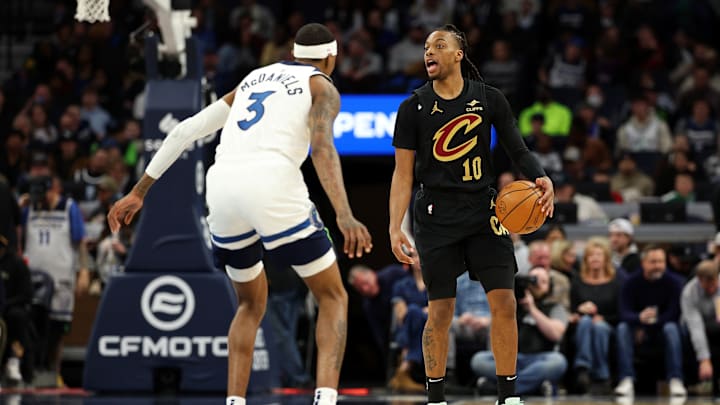With two young contending franchises reaching an impasse, the Cleveland Cavaliers and Minnesota Timberwolves could be perfect trade partners this summer.
Following a shocking trade last summer, the Timberwolves reached the Western Conference Finals with a core of Anthony Edwards, Rudy Gobert and Julius Randle. Though the beginning of the season had rough patches, the trio discovered a working system and began to eviscerate competition in the west. In the playoffs, Ant-Man stepped up his game, averaging 25.3 points, 7.8 rebounds and 5.5 assists on great efficiency. Still, Minnesota's efforts were not enough to take down the monolith Oklahoma City Thunder.
As for the Cavaliers, an unexpected buzzsaw run by the Indiana Pacers has brutalized the Eastern Conference playoffs. In three rounds, the Pacers have lost just four games en route to the Finals. Cleveland was the second victim of Indy's trampling run, losing in five games despite homecourt advantage. The Cavs won 64 games in the regular season and enjoyed three players named to the All-Star roster, but another bout with injury luck and disappearing depth cost them the series.
Where the Timberwolves falter, though, the Cavs thrive. Minnesota's offense is entirely dependent on the leadership of Mike Conley. At 37 years old, Conley's veteran presence and high basketball IQ broke down defenses and created open looks for his teammates. Unfortunately, Conley's age has kept him from logging heavy minutes, and the Wolves do not have a reliable backup to their aging leader.
With recent news suggesting the Cavs are more willing to explore trades involving Darius Garland or Jarrett Allen, Cleveland could pose a unique trade partner with Minnesota. Garland, a two-time All-Star point guard, could be the missing piece to the Timberwolves' playoff puzzle.
In a blockbuster move, the Cavs and Timberwolves could drastically reimagine their rosters and build fearsome contenders.
Building the trade
Financially, both Minnesota and Cleveland are bound by the Collective Bargaining Agreement restrictions. Including a third team, however, could alleviate much of the burden. The Cavs are currently over the second apron, meanwhile the Wolves are over the luxury tax but below the second tier. This allows Minnesota more flexibility in a trade, but a deal could create a hard cap at the second apron threshold.
After years of painstakingly refusing to enter a rebuild, the Chicago Bulls seem to be open for business. With a rebuilding underway, the Bulls become a perfect candidate to serve as a middle man in this trade.
In this trade, the Bulls add a young point guard in Rob Dillingham as the Timberwolves shift to playing Garland and Conley as their point guard rotation. Garland steps into the starting role, allowing Conley to play fewer minutes and stay rested for tight games. In exchange, though, Minnesota pays a hefty price to add another All-Star to their core. Losing Dillingham could be an expensive fee, but the newest Minnesota rookie struggled to stay in the rotation, especially as the postseason approached.
On Chicago's side, they find the point guard of the future, pairing Dillingham with Coby White and Josh Giddey to create a backcourt depth chart full of potential. DiVicenzo becomes Chicago's defacto veteran leader and a valuable wing player.
Where negotiations grow tense is the return for the Cavs. For Garland, Cleveland receives Jaden McDaniels, Lonzo Ball and the 17th overall pick in this year's draft. This trade reshaped the Cavs core with an oversized defensive guard in Lonzo, a proven playoff performer in McDaniels and a cost-effective rookie.
Who says no?
Minnesota may find the cost too high. The 17th pick may be negotiated into sending multiple first-round swaps from Cleveland back to Minnesota, further complicating the 2022 Donovan Mitchell trade. Trading DiVincenzo might be a positive move from the Timberwolves, though, as the former New York Knicks swingman never fully integrated into Minnesota's system.
While the Timberwolves have appreciated McDaniels' impact, his lackluster self-creation presents a serious problem for his future in Minnesota. With the potential of Randle or Naz Reid exiting the franchise in free agency, the Wolves can use this trade as an opportunity to safeguard against this. If both players return to Minnesota, Garland's addition only offers another star to bolster the team's Finals potential.
The Cavaliers might hesitate to trade Garland without a greater haul. Lonzo Ball is a talented distributor and a solid defensive guard, but his injury past could be a major cause for concern. Still, McDaniels gives Cleveland a 6-foot-9 wing who perfectly complements the offense Kenny Atkinson has built. Placing McDaniels into the forward rotation with Max Strus and De'Andre Hunter creates a fearsome lineup for the Cavaliers to unleash next season.
McDaniels could serve as a Swiss Army Knife player, filling in at the shooting guard, small forward or power forward position. His potential fit in lineups with Donovan Mitchell, Evan Mobley and Max Strus could push opponents to the limit with offensive firepower and punishing defense. Although the Cavaliers have restated a desire to win with the current core, moving on from Garland to construct a roster built for playoff success cannot be ignored.
Overall, all three teams find a new direction for the future while maintaining their identities. The Timberwolves could establish their backcourt for the future and still prioritize re-signing Randle, Naz Reid and Nickeil Alexander-Walker this summer. The Bulls lean into a youth movement, and the Cleveland Cavaliers restructure the core.
